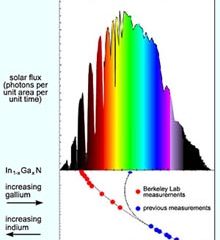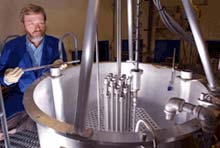Power and Electrical Engineering
This topic covers issues related to energy generation, conversion, transportation and consumption and how the industry is addressing the challenge of energy efficiency in general.
innovations-report provides in-depth and informative reports and articles on subjects ranging from wind energy, fuel cell technology, solar energy, geothermal energy, petroleum, gas, nuclear engineering, alternative energy and energy efficiency to fusion, hydrogen and superconductor technologies.

Energy network launches international web survey
A European website designed to stimulate informed debate on future energy sources this week launches a multi-lingual survey to gauge public attitudes to, and knowledge of, crucial energy issues.
The INTUSER website (www.intuser.net) is a new on-line forum for both the general public and energy experts to communicate about energy issues – from nuclear power and global warming to alternative energy sources such as solar and wave power.
Renewable energy expert Robin Saunders, of the Un

Silicon transistors will encounter pressure from nanoelectronics
The future of nanoelectronics looks promising. Built with nanotubes and various self-assembling molecular structures, this technology may revolutionize the electronic world by replacing the silicon transistor in approximately ten years.
Chemically synthesized nano building blocks are expected to replace semiconductor logic and memory devices and target niche applications over the next decade.
“In 20 to 50 years, we will likely see wide-ranging use of self-assembly,” says Technical I

An unexpected discovery could yield a full spectrum solar cell
Researchers in the Materials Sciences Division (MSD) of Lawrence Berkeley National Laboratory, working with crystal-growing teams at Cornell University and Japan’s Ritsumeikan University, have learned that the band gap of the semiconductor indium nitride is not 2 electron volts (2 eV) as previously thought, but instead is a much lower 0.7 eV.
The serendipitous discovery means that a single system of alloys incorporating indium, gallium, and nitrogen can convert virtually the full spectru

Alberta Research Council reaches major milestone in the development of micro fuel cell technology
A first in Canada, the Alberta Research Council (ARC) reached a milestone in the technical development of its own version of solid oxide fuel cell (SOFC) technology. ARC scientists are developing a proprietary micro solid oxide fuel cell (µ-SOFC) source of energy for small-scale portable applications such as laptops or personal digital assistants (PDAs).
“This is an important milestone as we pursue our strategic initiative in fuel cell technologies,” says John Zhou, manager, Advanced Materi

Pablo Sanchis solves the detection of the “island effect”
The “island effect” is one of the main problems in photovoltaic compound solar systems.
The doctoral thesis of Pablo Sanchis, presented in the Public University of Navarre (Basque Country), proposes three main contributions: the first one is a new control strategy of a booster inverter for autonomous systems; the second one is a new implementation of impedance measurement method, and the third one, a new methodology for the design of drift method in frequency, which guarantees with t

Reactor research could save money on nuclear waste handling
Recent experiments by Sandia National Laboratories researcher Gary Harms and his team are using a new Labs-built reactor to provide benchmarks showing that spent nuclear fuel — uranium that has been used as fuel at a nuclear power plant — is considerably less reactive than the original fresh fuel. This could mean significant savings in the eventual safe transport, storage, and disposal of nuclear waste.
“The conservative view has always been to treat spent fuel like it just came out of the